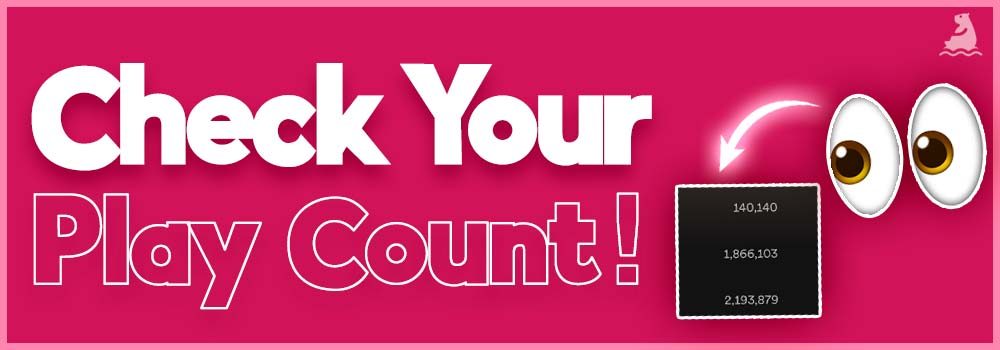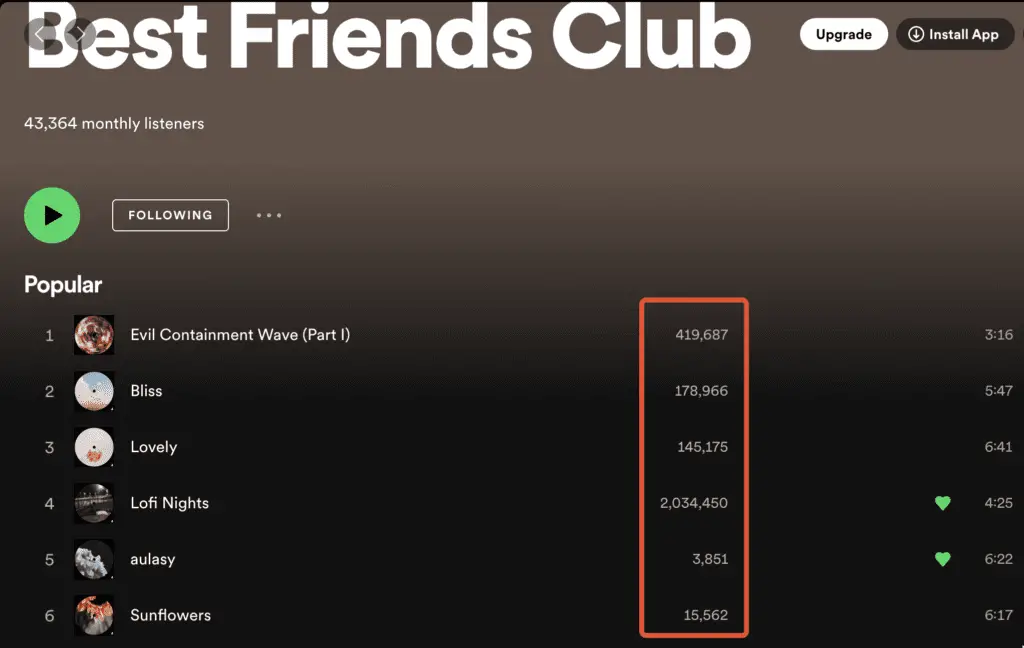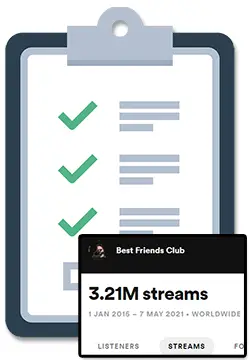Whether you are a listener or an artist, you may want to check on a song’s total stream or play count on Spotify. I’ve looked up and tested the best ways to track Spotify streams and written about it here.
Artists can use the Spotify For Artists dashboard to check their stream stats sorted by time period, location, and even playlist. Listeners can check a song’s total listens by visiting the artist’s Spotify profile and checking the songs listed under the “Popular” section.
If you want to check your own personal Spotify streams (as in how many times you’ve streamed a song or artist), check out my article called: Spotify Analytics For Listeners: Spotify Stats & Streams Tracker 🙂
If you are not the artist, you can only see the total play counts or total streams of songs that are listed in the “Popular” section. Total play counts can not be found anywhere else unless you are the artist and have access to the Spotify For Artists dashboard.
For a more detailed, step-by-step approach to both methods, simply read on, my friend!:)
How To See Play Counts On Spotify

There are two main methods to check Spotify play count, depending on whether you have a listener profile or an artist profile.
- Listener profiles are either free or paid versions of Spotify you use to listen to and discover music on the Spotify app or web browser.
- Artist profiles are the profiles you use to manage your songs and view your stats when you distribute and release music on to Spotify.
First, we will look into the basic way to see how many streams a song has on Spotify
4 Steps To Viewing Spotify Song Stream Count As A Listener
To view play counts for songs on Spotify, simply follow these steps:
#1 – Open up the Spotify app or web browser.
#2 – Type in the artist you are looking for in the search engine.
#3 – Click through to the profile of the artist.
#4 – Under the “Popular” section, you will see play counts to the right of each song.

At the time of writing this, it is only possible to see the play counts of songs that appear in the “Popular” section of an artist’s profile.
You are not able to see the play counts for a song that is not listed in the “Popular” section. Also – any songs that have less than 1,000 total play counts will show up as “>1000”, even if they are listed in the “Popular” section.
How To Track Your Spotify Streams As An Artist
If you are an artist on Spotify and want to see the play counts of your own songs, there is an even better way…
Spotify artists can view the listen and stream counts of any of their songs on Spotify by accessing their Spotify For Artists dashboard. Once logged in to your profile, you can easily view your stream stats sorted by time period, location, and even playlist.
In addition to being able to simply view stream and Spotify play counts, in an interview with Emily White, the Artists Product Manager at Spotify, states that:
“The most important thing in Spotify for Artists is access to data that helps you gain an understanding of who and where your audience is and what songs are connecting with listeners the most.”
Emily White, Spotify
So how can you get access to the Spotify For Artists dashboard so that you can get access to stats and the ability to make Spotify editorial playlist submissions if you yourself are an artist?
Great question!
Let’s take a closer look at this in the section below, my friend! 🙂
How to Claim an Artist’s Spotify Profile?
To gain access to Spotify for Artists, you must ensure that you have at least one track available on the platform, which has been provided by a record label or distributor. To establish your identity as the artist or their authorized representative, you should register with an email address that corresponds to your artist name or website domain.
After successfully signing up, you’ll promptly receive a confirmation email from Spotify. Following this, you can either download the Spotify for Artists mobile app for iOS or Android or access the Spotify for Artists dashboard via the web.
To sum it up, the process involves:
- Visit the Spotify for Artists website and click the “Get Access” button.
- Log in using an existing Spotify account or create a new one if needed.
- Search for your artist profile name and select it from the provided list.
- Submit your access request, providing the required basic information.
Once your request gets approved, you’ll be granted access to the Spotify for Artists platform, allowing you to monitor your streaming statistics.
What Can I Do With My Spotify for Artists Profile?
With Spotify for Artists, you can:
- Create and personalize your artist page with photos, a bio, and links to your social media profiles like Facebook, Instagram, and TikTok.
- Check real-time stats on how many people are currently listening to your songs.
- Track the total number of streams your songs have received over time, broken down by song, album, playlist, country, and city.
- Identify the Spotify users who are adding your songs to their playlists and even follow them.
- Submit your unreleased music to be considered for placement on Spotify’s official playlists by their editorial team.
- Access a variety of tools and advice to help you grow your audience on Spotify.
How Often Are Spotify Plays Updated?
For Artists on Spotify:
Music Tab: This section in the Spotify for Artists dashboard or app gives you detailed stats about how many times your songs have been played. It shows data for different timeframes like today, yesterday, the last 7 days, and the last 28 days. These stats are updated once a day, usually around 3 PM EST/8 PM UTC. You can also see which playlists feature your songs and how many streams they generate with the Spotify stream checker tool.
Audience Tab: In this section, you can learn about your listeners on Spotify. It provides information about their age groups, gender, top countries, and whether they are dedicated fans or casual listeners. You can also find out where most of your Spotify plays are coming from, whether it’s playlists, recommendations, or direct searches.
Live Stream Count: After you release new music, you can see how many streams it’s getting in real-time during the first seven days. This live metric updates every two seconds, helping you see how your new music is doing on Spotify right away.
How To Become A Spotify Artist

To get access to the Spotify For Artists dashboard and become a verified Spotify artist (like me), you must first actually have music released on Spotify.
So… how do you get your music on Spotify?
To get your music on Spotify, you need to work with a distributor or with a record label that already has a distributor. They handle all the licensing and distribution and pay your streaming royalties.
Spotify
Once you have your music on Spotify, you can simply claim your artist profile by visiting this page.
However, some distributors (like DistroKid), actually automatically claim your artist profile for you when you distribute music through them.
On top of this, it is actually very easy and surprisingly cheap to do this (I ended up using DistroKid myself because of how easy and cheap it is to use).
For a detailed look into this, check out my article on how to create a Spotify artist account (you’ll even learn how to get that beautiful blue verified check mark).
However, for the best and easiest way to get your music on Spotify properly, take a closer look at DistroKid and my big fat DistroKid review to learn everything about them.
There is even a handy How To Choose A Distributor Guide and some info on the nice DistroKid discount.
With that said, it is always a good idea to do some of your own research and see what other distributors are out there on the market.
Some other options to check out
Although I personally use, love, and recommend DistroKid, it is always a good idea to see how they compare to the other guys.
Luckily for you, I’ve done just that.
Check out the comparisons of DK to some other popular music distributors:
- DistroKid vs TuneCore
- DistroKid vs CD Baby
- DistroKid vs Amuse
- DistroKid vs Ditto
- DistroKid vs UnitedMasters
- DistroKid vs SoundCloud
However, if you would like to get your music on Spotify for free, there are some catches, but it is completely doable!
Let’s take a look into how you can get your tunes on Spotify for free, just below.:)
How To Become An Artist On Spotify For Free
There is a service called RouteNote.com that allows you to upload music to Spotify for free. Definitely check them out if you find that spending $19.99 for unlimited song releases is too much for you at this time.
No judgment, my friend!:)
However, I did mention that there is a catch…
Unlike DistroKid, RouteNote actually takes a 15% cut of any song royalties that you may receive.
What that means is if any of your songs take off and start actually bringing in some cash, RouteNote will always be stripping you of your hard-earned dollars.
To get a better idea of how much you stand to lose, learn how to find & use the best Spotify stream calculator so you can calculate potential royalty earnings based on the number of streams.
On top of this, RouteNote does have paid plan versions that are weird and complicated. You pay $30 per year in the first few years and then need to start paying $10 per single and $50 per album. WTF?
Obviously, I am a little biased because I use and love DistroKid, but this complicated pricing structure seems fishy to me.
…Especially when compared to the much simpler (and better imo) DistroKid pricing.
But with that said, if you are just dipping your toes into the water of releasing music on Spotify, this really can be a fantastic way to get started.
Finally, I should mention that if the cost of DistroKid is too high for you, you can actually follow this link to save 7%. It’s not a crazy amount of savings, but hopefully, it can help you out. 🙂
Spotify Stream Tracker: The Best Way To Grow Your Spotify Streams
In an article that I previously wrote about what to do if your Spotify stream count is not updating, I discovered the best way to track (and grow) your Spotify streams…
Build your own custom Spotify stream count tracker using spreadsheets.
But how, you ask?
By using spreadsheet software like Google Sheets or Microsoft Excel, you can basically build your own simple app that you can use to track your growth and key Spotify metrics.
To learn more about this, check out my article on the Spotify Tracker For Artists.
In addition to tracking your Spotify stream count, a tracker like this is also a great way to calculate your listeners, save rate, and listen rate (all of which help you in the Spotify algorithm).
Just make sure you know what the difference between streams and listeners on Spotify is first.
And, of course, you have your music up on Spotify and have access to the Spotify For Artists dashboard.
How To Get More Spotify Streams
What makes Spotify so awesome is that they have built a whole bunch of ways for artists to grow their streams (and revenue) naturally right within Spotify.
They’ve done this by creating two types of playlists:
- Spotify algorithm playlists
- Spotify editorial playlists
Getting on any of these will significantly increase the number of streams your music gets.
So how do you get on these bad boys?
The honest secret is this…
Release music often.
This is exactly why I really think it is important to choose a music distributor that provides unlimited song uploads for a small fee, like DistroKid.
Otherwise, releasing lots of music can get really expensive really quickly.
How do I know this?
Simple!
I’ve done this myself by releasing my own music on a monthly basis.
At first, I started getting on some Algorithmic playlists, and slowly that caught the attention of the Spotify editors.
I’ve now gotten my music on over ten official Spotify editorial playlists and have racked up over 2 million streams.
If you want to know how I did this in detail, I put together a free course called the 6 Secrets To Spotify Success.
In this free course, I cover:
- How to get the most out of your latest release overnight
- The exact step-by-step process of how to build a music marketing strategy required to make you sweet streams
- How to grow your Spotify stream count, monthly listeners, and fans even if you’re totally new
If that sounds neat to you, then check out the 6 Secrets To Spotify Success for more.
Otherwise, good luck on your next release, my friend! 🙂
Related Questions
Can I see how many times I’ve played a song on Spotify?
Great question! Spotify does not show you how many times you have played a song on Spotify. However, if a song shows up in your “On Repeat” playlist, that is a good signal that you’ve listened to a song quite a few times.
How can I see how much time I have listened to music on Spotify?
Another great question! Spotify does not show you how much time you have listened to music on Spotify. However, you can connect your Spotify account to a service like Last.FM to get this data (starting from the date that you connect the service).
How to check streams on Spotify?
To see Spotify streams, you can follow these steps:
- Use the Spotify app or website.
- Search for the artist’s name.
- Open the artist’s profile.
- Check the play counts for each song in the “Popular” section.
How to see how many streams a song has on Spotify?
To see how many streams a song has on Spotify, you can:
- Visit the artist’s profile page on Spotify.
- Look for the song in the “Popular” section.
- The play count for that song will be displayed.
How to see streams on Spotify?
To check how many times a song has been played on Spotify, you can do it in two ways:
As a Listener:
- Use the Spotify app or website to listen to music. You can explore songs and see how many times they’ve been played.
As an Artist:
- If you’re an artist, you can go to your “Spotify For Artists” dashboard.
- There, you’ll find detailed stats about your music, including the number of streams and information about the people listening to your songs.
How to see how many times a song has been played on Spotify?
Another great question! If you want to know how many times a song has been played on Spotify, go to the artist’s Spotify profile. Look for the “Popular” section. Most songs will show their play counts there. But if a song isn’t in the “Popular” section or has fewer than 1,000 streams, it will show up as “>1000”.




